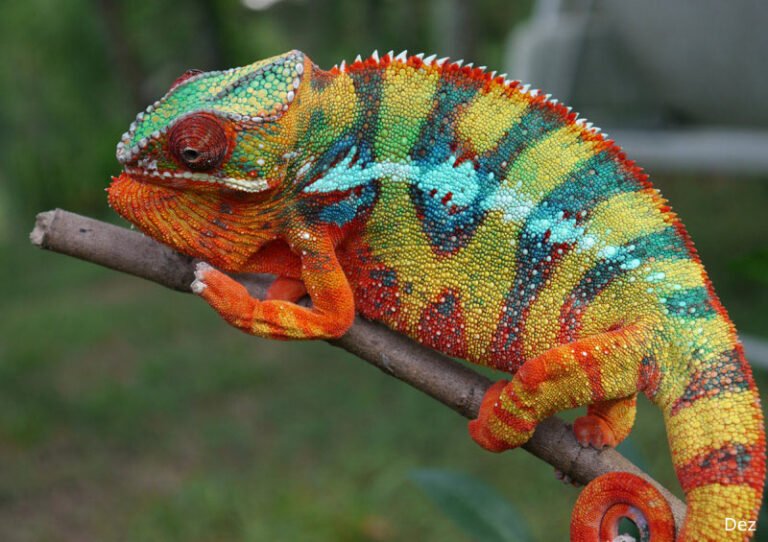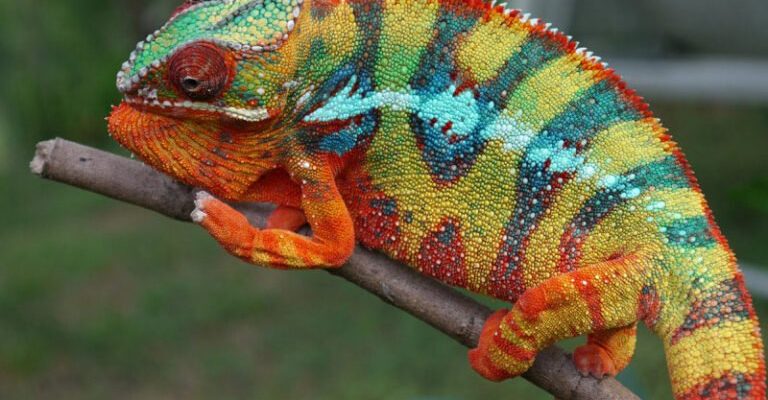
So, let’s dive into the world of panther chameleons and explore what they eat, how often they should be fed, and how to ensure they’re getting all the nutrients they need. It’s more than just crickets and mealworms, and I promise it’s easier than putting together an elaborate meal for your friends!
Understanding the Panther Chameleon’s Natural Diet
To provide the best diet for your panther chameleon, it’s helpful to understand what they eat in the wild. These little guys are *insectivores*, meaning their primary food source consists of insects. In their natural habitat, they snack on a variety of bugs, including crickets, grasshoppers, and even some small caterpillars. Think of them as the crafty hunters of the reptile world, using their keen eyesight to spot prey from a distance before striking with their long, quick tongues.
What’s fascinating is that their diet can vary significantly based on their environment. In the lush forests of Madagascar, they have access to a diverse range of insects, which helps them get all the vitamins and minerals they need. This is where the concept of a varied diet becomes important; in captivity, you want to replicate that diversity as much as possible. This means introducing different insects and, occasionally, fruits or vegetables to their meals.
Main Food Sources for Panther Chameleons
Now, let’s break down some of the *main food sources* you can offer your panther chameleon:
- Crickets: These are perhaps the most popular choice. They’re easy to find, and chameleons love to hunt them. Just ensure they’re gut-loaded (fed a nutritious diet) before serving!
- Mealworms: These can be a tasty treat, but they should only make up a small part of the diet since they have a higher fat content.
- Roaches: Dubia roaches are a favorite for many chameleon owners. They’re nutritious and don’t smell as much as other feeders.
- Waxworms: These are more of a dessert—very fatty and sugary, so use them sparingly.
- Vegetables and fruits: While chameleons are primarily insectivores, you can offer small amounts of things like squash or papaya for some variety. Just keep it to a minimum!
It’s good to remember that variety is key here. By mixing up the protein sources, you’ll not only keep your chameleon interested in their meals, but you’ll also ensure they’re getting a balanced array of nutrients. You might be wondering how you can find all these insects—many pet stores carry them, and there are even online suppliers that specialize in feeder insects.
Creating a Feeding Schedule
Now that you know what to feed your panther chameleon, let’s talk about when to feed them. A regular feeding schedule helps to maintain their health and prevents them from getting stressed out. Ideally, you’ll want to establish a routine.
For adult panther chameleons, a good feeding schedule might look like this:
- Feed every other day (3-5 insects per feeding).
- Occasionally offer a larger meal (up to 10 insects) once a week.
For babies and juveniles, their growing bodies require more food, so a slightly different approach works better:
- Feed every day (5-10 insects per feeding).
- Make sure they get a variety of insects in one feeding.
It’s worth noting that chameleons are visual hunters. So, try to feed them in the morning when they’re most active. This mimics their natural hunting behavior and encourages them to eat.
Supplementing Your Panther Chameleon’s Diet
Feeding your panther chameleon a balanced diet of insects is great, but there’s more you can do to ensure they get all the essential nutrients. This is where supplements come into play. Just like you might take vitamins to stay healthy, your chameleon can benefit from a few key supplements too.
You should use a calcium supplement at least 2-3 times a week. Here’s the thing: chameleons need calcium to prevent metabolic bone disease, which can be fatal. A good calcium powder can help with that. Additionally, it’s helpful to use a multivitamin supplement every 1-2 weeks to provide extra nutrients that might be lacking in their diet.
When using supplements, it’s best to dust them on the insects before you feed them. This ensures your chameleon gets the full benefit without the risk of overdosing on any one vitamin.
Hydration: The Unsung Hero of Chameleon Care
While we’re on the topic of feeding and nutrition, let’s not overlook the importance of hydration. Panther chameleons don’t drink from a water bowl like many other reptiles. Instead, they prefer to drink water droplets off leaves. This means you need to keep their habitat humid and misted regularly.
You might want to invest in a misting system or manually mist the enclosure a couple of times a day. This not only provides drinking water but also helps with their shedding and keeps their skin healthy. You’ll often see them drinking water droplets, which is a fantastic sign that they’re hydrated.
In addition to misting, consider offering a shallow dish with water, just in case. Some chameleons may enjoy taking a drink that way, though it’s not their go-to method.
Common Feeding Mistakes to Avoid
Even seasoned chameleon owners can make mistakes when it comes to feeding. Here are a few common blunders to watch out for:
- Overfeeding: It’s easy to think that more food equals better health, but overfeeding can lead to obesity. Stick to the suggested amounts!
- Ignoring variety: Feeding the same type of insect can lead to nutritional deficiencies. Mix it up!
- Not gut-loading insects: If you’re not feeding your feeder insects a nutritious diet before giving them to your chameleon, you’re missing out on essential nutrients.
- Forgetting supplements: Make sure to incorporate calcium and multivitamins, as neglecting these can have severe health consequences.
By avoiding these pitfalls, you’ll be well on your way to ensuring your panther chameleon has a healthy and balanced diet.
Feeding a panther chameleon might feel a bit daunting at first, but once you get the hang of it, it becomes second nature. Remember, a balanced diet filled with variety, supplements, and proper hydration is essential for their health. This means mixing up their insects, sticking to a routine, and paying attention to their hydration needs.
By offering them a thoughtful diet, you’re not only making sure they thrive but also enhancing their natural behaviors and personality. So, gear up for the exciting journey of feeding your chameleon, and enjoy watching your little friend flourish!

